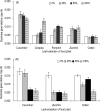Host Plant Determines the Population Size of an Obligate Symbiont (Buchnera aphidicola) in Aphids
- PMID: 26850304
- PMCID: PMC4959500
- DOI: 10.1128/AEM.04131-15
Host Plant Determines the Population Size of an Obligate Symbiont (Buchnera aphidicola) in Aphids
Abstract
Buchnera aphidicolais an obligate endosymbiont that provides aphids with several essential nutrients. Though much is known about aphid-Buchnera interactions, the effect of the host plant on Buchnera population size remains unclear. Here we used quantitative PCR (qPCR) techniques to explore the effects of the host plant on Buchnera densities in the cotton-melon aphid, Aphis gossypii Buchneratiters were significantly higher in populations that had been reared on cucumber for over 10 years than in populations maintained on cotton for a similar length of time. Aphids collected in the wild from hibiscus and zucchini harbored more Buchnera symbionts than those collected from cucumber and cotton. The effect of aphid genotype on the population size of Buchnera depended on the host plant upon which they fed. When aphids from populations maintained on cucumber or cotton were transferred to novel host plants, host survival and Buchnera population size fluctuated markedly for the first two generations before becoming relatively stable in the third and later generations. Host plant extracts from cucumber, pumpkin, zucchini, and cowpea added to artificial diets led to a significant increase in Buchnera titers in the aphids from the population reared on cotton, while plant extracts from cotton and zucchini led to a decrease in Buchnera titers in the aphids reared on cucumber. Gossypol, a secondary metabolite from cotton, suppressed Buchnera populations in populations from both cotton and cucumber, while cucurbitacin from cucurbit plants led to higher densities. Together, the results suggest that host plants influence Buchnera population processes and that this may provide phenotypic plasticity in host plant use for clonal aphids.
Copyright © 2016, American Society for Microbiology. All Rights Reserved.
Figures





Similar articles
-
Refuges and host shift pathways of host-specialized aphids Aphis gossypii.Sci Rep. 2017 May 17;7(1):2008. doi: 10.1038/s41598-017-02248-4. Sci Rep. 2017. PMID: 28515483 Free PMC article.
-
Infections with Arsenophonus Facultative Endosymbionts Alter Performance of Aphids (Aphis gossypii) on an Amino-Acid-Deficient Diet.Appl Environ Microbiol. 2019 Nov 14;85(23):e01407-19. doi: 10.1128/AEM.01407-19. Print 2019 Dec 1. Appl Environ Microbiol. 2019. PMID: 31540983 Free PMC article.
-
Buchnera breaks the specialization of the cotton-specialized aphid (Aphis gossypii) by providing nutrition through zucchini.Front Nutr. 2023 Mar 21;10:1128272. doi: 10.3389/fnut.2023.1128272. eCollection 2023. Front Nutr. 2023. PMID: 37025616 Free PMC article.
-
Genetics, physiology, and evolutionary relationships of the genus Buchnera: intracellular symbionts of aphids.Annu Rev Microbiol. 1995;49:55-94. doi: 10.1146/annurev.mi.49.100195.000415. Annu Rev Microbiol. 1995. PMID: 8561471 Review.
-
Facultative symbionts are potential agents of symbiont-mediated RNAi in aphids.Front Microbiol. 2022 Nov 23;13:1020461. doi: 10.3389/fmicb.2022.1020461. eCollection 2022. Front Microbiol. 2022. PMID: 36504780 Free PMC article. Review.
Cited by
-
Vat, an Amazing Gene Conferring Resistance to Aphids and Viruses They Carry: From Molecular Structure to Field Effects.Front Plant Sci. 2016 Sep 26;7:1420. doi: 10.3389/fpls.2016.01420. eCollection 2016. Front Plant Sci. 2016. PMID: 27725823 Free PMC article. Review.
-
The nutritional dimension of facultative bacterial symbiosis in aphids: Current status and methodological considerations for future research.Curr Res Insect Sci. 2023 Dec 20;5:100070. doi: 10.1016/j.cris.2023.100070. eCollection 2024. Curr Res Insect Sci. 2023. PMID: 38222793 Free PMC article. Review.
-
Symbiotic microbial studies in diverse populations of Aphis gossypii, existing on altered host plants in different localities during different times.Ecol Evol. 2021 Sep 23;11(20):13948-13960. doi: 10.1002/ece3.8100. eCollection 2021 Oct. Ecol Evol. 2021. PMID: 34707830 Free PMC article.
-
Diversity and dynamics of endosymbionts in a single population of sweet potato weevil, Cylas formicarius (Coleoptera: Brentidae): a preliminary study.J Insect Sci. 2023 Mar 1;23(2):13. doi: 10.1093/jisesa/iead021. J Insect Sci. 2023. PMID: 37052365 Free PMC article.
-
Potato leafroll virus reduces Buchnera aphidocola titer and alters vector transcriptome responses.Sci Rep. 2021 Dec 14;11(1):23931. doi: 10.1038/s41598-021-02673-6. Sci Rep. 2021. PMID: 34907187 Free PMC article.
References
-
- von Dohlen CD, Moran NA. 2000. Molecular data support a rapid radiation of aphids in the Cretaceous and multiple origins of host alternation. Biol J Linn Soc 71:689–717. doi:10.1006/bijl.2000.0470. - DOI
-
- Houk EJ, Griffiths GW. 1980. Intracellular symbiotes of Homoptera. Annu Rev Entomol 25:161–187. doi:10.1146/annurev.en.25.010180.001113. - DOI
Publication types
MeSH terms
LinkOut - more resources
Full Text Sources
Other Literature Sources

